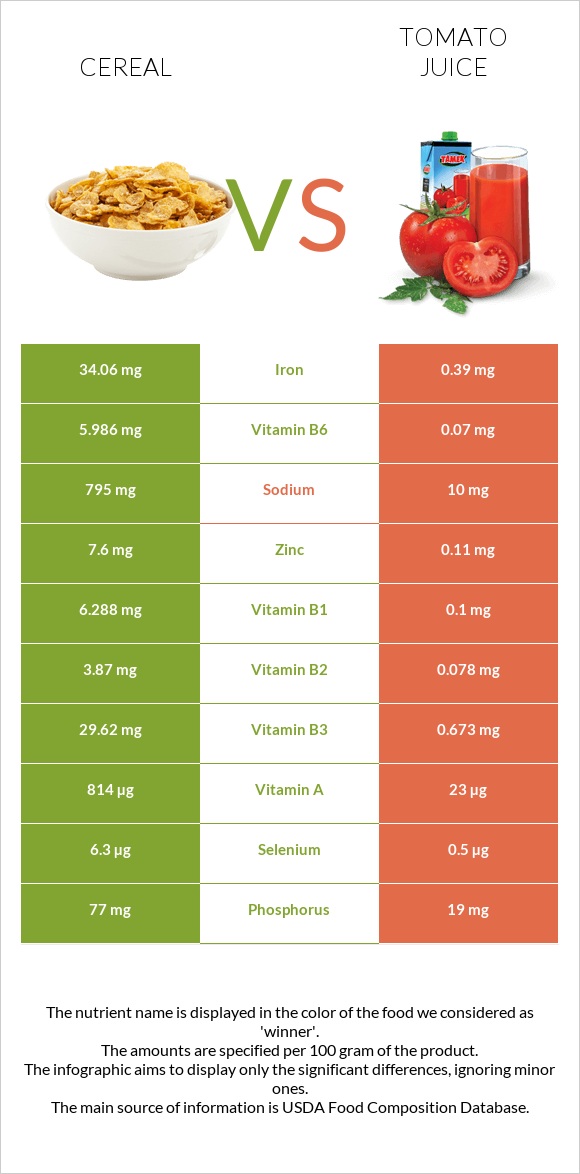Cereal vs. Tomato juice — In-Depth Nutrition Comparison
Compare
The main differences between cereal and tomato juice
- Cereal is richer in vitamin B1, vitamin B6, iron, vitamin B2, vitamin B3, zinc, vitamin A, and manganese, yet tomato juice is richer in vitamin C.
- Daily need coverage for vitamin B1 for cereal is 516% higher.
- Cereal contains 87 times more iron than tomato juice. Cereal contains 34.06mg of iron, while tomato juice contains 0.39mg.
- Tomato juice contains less sodium.
- Tomato juice has a lower glycemic index than cereal.
Food types used in this article are Cereals ready-to-eat, USDA Commodity Corn and Rice (includes all commodity brands) and Tomato juice, canned, without salt added.
Infographic

Infographic link
Mineral Comparison
Mineral comparison score is based on the number of minerals by which one or the other food is richer. The "coverage" charts below show how much of the daily needs can be covered by 300 grams of the food.
| Contains more MagnesiumMagnesium | +72.7% |
| Contains more IronIron | +8633.3% |
| Contains more CopperCopper | +226.2% |
| Contains more ZincZinc | +6809.1% |
| Contains more PhosphorusPhosphorus | +305.3% |
| Contains more ManganeseManganese | +1061.8% |
| Contains more SeleniumSelenium | +1160% |
| Contains more PotassiumPotassium | +106.7% |
| Contains less SodiumSodium | -98.7% |
Vitamin Comparison
Vitamin comparison score is based on the number of vitamins by which one or the other food is richer. The "coverage" charts below show how much of the daily needs can be covered by 300 grams of the food.
| Contains more Vitamin AVitamin A | +3439.1% |
| Contains more Vitamin B1Vitamin B1 | +6188% |
| Contains more Vitamin B2Vitamin B2 | +4861.5% |
| Contains more Vitamin B3Vitamin B3 | +4301.2% |
| Contains more Vitamin B5Vitamin B5 | +∞% |
| Contains more Vitamin B6Vitamin B6 | +8451.4% |
| Contains more Vitamin CVitamin C | +82.1% |
| Contains more Vitamin EVitamin E | +300% |
| Contains more Vitamin KVitamin K | +∞% |
All nutrients comparison - raw data values
| Nutrient |  |
 |
DV% diff. |
| Vitamin B1 | 6.288mg | 0.1mg | 516% |
| Vitamin B6 | 5.986mg | 0.07mg | 455% |
| Iron | 34.06mg | 0.39mg | 421% |
| Vitamin B2 | 3.87mg | 0.078mg | 292% |
| Vitamin B3 | 29.62mg | 0.673mg | 181% |
| Vitamin A | 814µg | 23µg | 88% |
| Zinc | 7.6mg | 0.11mg | 68% |
| Vitamin C | 38.5mg | 70.1mg | 35% |
| Sodium | 795mg | 10mg | 34% |
| Manganese | 0.79mg | 0.068mg | 31% |
| Carbs | 86.85g | 3.53g | 28% |
| Calories | 378kcal | 17kcal | 18% |
| Copper | 0.137mg | 0.042mg | 11% |
| Selenium | 6.3µg | 0.5µg | 11% |
| Protein | 6.06g | 0.85g | 10% |
| Phosphorus | 77mg | 19mg | 8% |
| Vitamin B5 | 0.226mg | 5% | |
| Folate | 20µg | 5% | |
| Fiber | 1.4g | 0.4g | 4% |
| Potassium | 105mg | 217mg | 3% |
| Magnesium | 19mg | 11mg | 2% |
| Vitamin E | 0.08mg | 0.32mg | 2% |
| Vitamin K | 0µg | 2.3µg | 2% |
| Polyunsaturated fat | 0.354g | 0.027g | 2% |
| Fats | 1.08g | 0.29g | 1% |
| Choline | 6.8mg | 1% | |
| Saturated fat | 0.26g | 0.019g | 1% |
| Fructose | 0.26g | 1.33g | 1% |
| Net carbs | 85.45g | 3.13g | N/A |
| Calcium | 10mg | 10mg | 0% |
| Sugar | 10.35g | 2.58g | N/A |
| Monounsaturated fat | 0.204g | 0.005g | 0% |
| Tryptophan | 0.066mg | 0.006mg | 0% |
| Threonine | 0.241mg | 0.026mg | 0% |
| Isoleucine | 0.26mg | 0.017mg | 0% |
| Leucine | 0.767mg | 0.024mg | 0% |
| Lysine | 0.113mg | 0.026mg | 0% |
| Methionine | 0.13mg | 0.005mg | 0% |
| Phenylalanine | 0.365mg | 0.026mg | 0% |
| Valine | 0.344mg | 0.017mg | 0% |
| Histidine | 0.162mg | 0.014mg | 0% |
| Omega-3 - ALA | 0.005g | N/A | |
| Omega-6 - Linoleic acid | 0.022g | N/A |
Macronutrient Comparison
Macronutrient breakdown side-by-side comparison
Protein:
6.06 g
Fats:
1.08 g
Carbs:
86.85 g
Water:
3.78 g
Other:
2.23 g
Protein:
0.85 g
Fats:
0.29 g
Carbs:
3.53 g
Water:
94.24 g
Other:
1.09 g
| Contains more ProteinProtein | +612.9% |
| Contains more FatsFats | +272.4% |
| Contains more CarbsCarbs | +2360.3% |
| Contains more OtherOther | +104.6% |
| Contains more WaterWater | +2393.1% |
Fat Type Comparison
Fat type breakdown side-by-side comparison
Saturated fat:
Sat. Fat
0.26 g
Monounsaturated fat:
Mono. Fat
0.204 g
Polyunsaturated fat:
Poly. Fat
0.354 g
Saturated fat:
Sat. Fat
0.019 g
Monounsaturated fat:
Mono. Fat
0.005 g
Polyunsaturated fat:
Poly. Fat
0.027 g
| Contains more Mono. FatMonounsaturated fat | +3980% |
| Contains more Poly. FatPolyunsaturated fat | +1211.1% |
| Contains less Sat. FatSaturated fat | -92.7% |
Carbohydrate type comparison
Carbohydrate type breakdown side-by-side comparison
Starch:
0 g
Sucrose:
9.74 g
Glucose:
0.27 g
Fructose:
0.26 g
Lactose:
0 g
Maltose:
0.09 g
Galactose:
0 g
Starch:
0 g
Sucrose:
0 g
Glucose:
1.25 g
Fructose:
1.33 g
Lactose:
0 g
Maltose:
0 g
Galactose:
0 g
| Contains more SucroseSucrose | +∞% |
| Contains more MaltoseMaltose | +∞% |
| Contains more GlucoseGlucose | +363% |
| Contains more FructoseFructose | +411.5% |
~equal in
Starch
~0g
~equal in
Lactose
~0g
~equal in
Galactose
~0g





